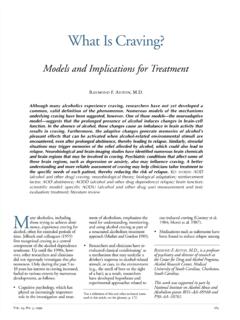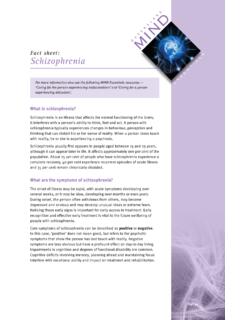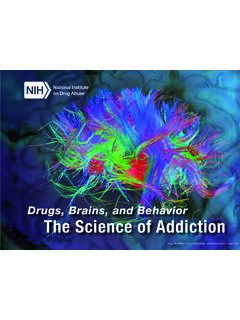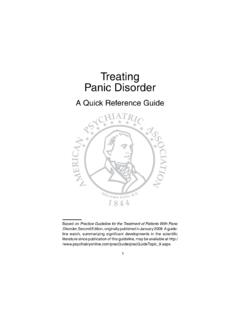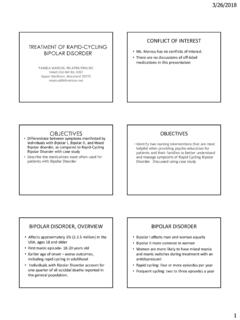Transcription of The Effects of Drugs - SAGE Pub
1 623 The Effects of DrugsPart IAs noted in Chapter 1, the use ofsubstances for their consciousness-altering Effects is ubiquitous in humanhistory. There is evidence that psychoactiveplants such as ephedra were used byNeanderthal man as far back as 50,000years ago (Merlin, 2003), and all civili-zations that have had access to thesesubstances have significant numbers ofindividuals who choose to use them. Thetendency to alter consciousness is not evenunique to humans: Animals, both domesti-cated and wild, have been shown to seekout intoxicating substances such as ferment-ing fruit or psychoactive plants (R. Siegel,1989). Drugs are often viewed as possessingan almost mystical quality in terms of theirability to generate psychoactive Effects , butit is important to recognize that these sub-stances do not create these Effects ; theysimply stimulate a natural function of thebrain.
2 Or, as Gahlinger (2001) comments, All drug sensations, feelings, awareness, or hallucinations can also be achieved with-out Drugs and alleffects of psychoactivedrugs can be produced naturally andspontaneously (p. 159).In Chapters 3 and 4, we discuss severaldrugs categorized by their subjective psy-choactive Effects as well as their Effects onthe body. This chapter will focus on the stimulants, depressants, inhalants, andopiates, and Chapter 4 will address the hal-lucinogens, PCP and ketamine, marijuana,antidepressants and aphrodisiacs, andsteroids and other performance-enhancingdrugs. There are significant differencesbetween these drug types and compared tothe other Drugs we address the antidepres-sants, aphrodisiacs, and steroids and otherperformance-enhancing Drugs stand , it is important to recognize thatthe antidepressants, aphrodisiacs, andperformance-enhancing Drugs share manycharacteristics in common with more tra-ditional psychoactive Drugs : All of thesesubstances have potential benefits anddrawbacks, all may be abused, and eachrepresents a means by which people mayalter their consciousness or it is true that antidepressantswill not get users high in the fashion ofother psychoactive Drugs , they do have theability to alter perception and mood;indeed, this is why they are useful in a med-ical context.
3 We do not question that thesedrugs have been very helpful for countlessindividuals suffering from mental illnessessuch as depression. But the fact remains that these substances alter consciousness, 11/28/2006 3:47 PM Page 62and this illustrates our point that conscious-ness alteration should not be seen as nega-tive per se; it is only when this tendency ismanifested in ways that are harmful toothers that it becomes , aphrodisiacs are clearly aunique form of drug in that their sole pur-pose is to allow for sexual pleasure (Shenk,1999). As discussed below, these Drugs mayallow for or assist in the attainment ofsexual pleasure by those who have lost theability to achieve erection/orgasm, but theyare also widely used recreationally by thosewho seek to enhance their sex life, despite theabsence of any problems with it.
4 Althoughwe do not see the use of these substances asdirectly analogous to the use of more tradi-tional psychoactive Drugs , aphrodisiacs aresimilar to the others discussed in the sensethat they are designed to assist in the achieve-ment of a state of overpowering emotion andfeeling in this case, sexual , we recognize that steroidsand (certain) other performance-enhancingdrugs are, in many respects, differentfrom the other substances discussed. Thesesubstances are used primarily to enhanceathletic performance and/or to improvephysique. Thus, while the primary motiva-tion for using performance-enhancing drugsis, to some degree, unique, the use of thesesubstances also represents an expression ofa basic human drive to stimulate the humanorganism beyond its normal metabolicstate (Hoberman, 1992, p. 105). In thissense, then, these Drugs are similar to othersthat will be discussed.
5 It is also important to recognize that steroids and similar sub-stances have also been shown to possessmood-altering Effects . Of these, aggressionis the most well-known, but more desir-able Effects associated with steroid useinclude euphoria, increased sexual desire,friendliness, and stimulant-like propertiesincluding alertness, decreased fatigue,increased energy and vitality, and improvedmemory and concentration (Bahrke, Yesalis,& Wright, 1996; Pope, Kouri, & Hudson,2000; Rubinow & Schmidt, 1996; Yates,2000). Although we are not making theclaim that steroids and similar substancesare initially taken in pursuit of these Effects ,the Effects may come to be important rea-sons that people continue to use these Effects of Drugs : Part I63 The only known societies that had no access to psychoactive substances were the Inuit, whotraditionally lived near the Arctic Circle, and some people of the Pacific Islands.
6 These groupsshared the trait of being extremely isolated from other civilizations, and when these peoplewere eventually exposed to psychoactive substances, especially alcohol, they exhibited catas-trophic rates of addiction and abuse (Gahlinger, 2001).It is also interesting to note that theeffects of Drugs are often seen as either good or bad depending on the contextof their use. However, it is important torecognize that Drugs are just substances,and regardless of their reputation and legalstatus, they affect the functioning of thebrain and corresponding mood states invery similar ways. This is because psychoac-tive Drugs either act on or resemble variousneurotransmitters, which are messengerchemicals that carry messages withinthe brain and from the brain to the restof the body. Commonly known neuro-transmitters include serotonin, dopamine,and adrenaline, and as Gahlinger (2001)notes, the Effects of a drug depend on whichneurotransmitters it resembles, and itspotency is partly determined by how closethis resemblance is (p.)
7 138). 11/28/2006 3:47 PM Page 63 Because of their psychoactive Effects , alldrugs have the potential to cause harm insociety, as drug users may harm people,either intentionally or accidentally, whileunder the influence. Some have referred tothis as a drug s behavioral toxicity(Ray &Ksir, 2004). Although this is difficult toassess (is it the drug or the person using thedrug that creates the problem?) and varieswith the potency and amount of the drugthat is taken, we discuss the subjective men-tal Effects of various Drugs and consider theirpotential behavioral from their subjective psychoactiveeffects, Drugs are also assessed in terms ofthe physical and psychological risks theypose to users. The risks presented by vari-ous Drugs are commonly assessed in termsof their toxicity,or ability to generate nega-tive health consequences in users, and theirpotential to result in dependency(oftenused interchangeably with addiction).
8 Toxicity can be both acute and toxicityrefers to problems that comeon immediately or very quickly, as in thecase of a drug overdose, whilechronic toxi-cityrefers to Effects that result from thelong-term exposure to the drug, such asemphysema associated with smoking orcirrhosis caused by alcohol consumption(Ray & Ksir, 2004).Although issues of acute toxicity areoften provided as justification for policiesagainst certain illegal Drugs , it is importantto recognize that many legal Drugs haveamong the highest levels of acute example, as noted in Chapter 5, pre-scription psychotherapeutic drugsandalcohol in combination with other sub-stances were the first and second leadingcauses of drug-related visits to hospitalemergency rooms in 2003, followed bycocaine (Substance Abuse and MentalHealth Services Administration [SAMHSA],2003b).
9 Similarly, despite the attentionpaid to acute toxicity, it is a drug s chronictoxicity that is, by far, most harmful interms of illness and loss of life. For example,alcohol and tobacco are estimated to beinvolved in the deaths of over 600,000 Americans every year, mostly as a result ofthe chronic toxicity of these Drugs . Althoughthe measurement of alcohol and tobaccomortality figures are confounded by otherfactors, estimates indicate that tobacco andalcohol kill between 75 and 100 times thenumber of people annually as all illegaldrugs combined (Gahlinger, 2001). Drugs can also be evaluated in terms oftheir ability to generate dependence, some-times called addiction. In layman s terms,these conditions collectively refer to a per-son s inability to stop using a drug when it iscausing him or her problems (Weil & Rosen,1998).
10 The terms dependence and addic-tion are very loosely used in society, andmany health professionals now avoid usingthe term addiction. In part, this is because addiction is commonly used to refer tomany behaviors that have nothing to do withdrugs or anything able to generate physicaldependence ( , sex, gambling, exercise,TV, shopping), suggesting that addiction ordependence has more to do with humanbeings than with Drugs (p. 171).Referring to substance use, there are twodistinct forms of dependence. The first isphysical (or physiological) dependence,which refers to the potential of a drug togenerate a withdrawal syndrome, or a pre-dictable set of symptoms that affect the userwhen the use of a drug is discontinued aftersome period of use (Weil & Rosen, 1998).Thus, Drugs that are not accompanied by awithdrawal syndrome when long-term orheavy use is stopped are not regarded asphysically addicting.










